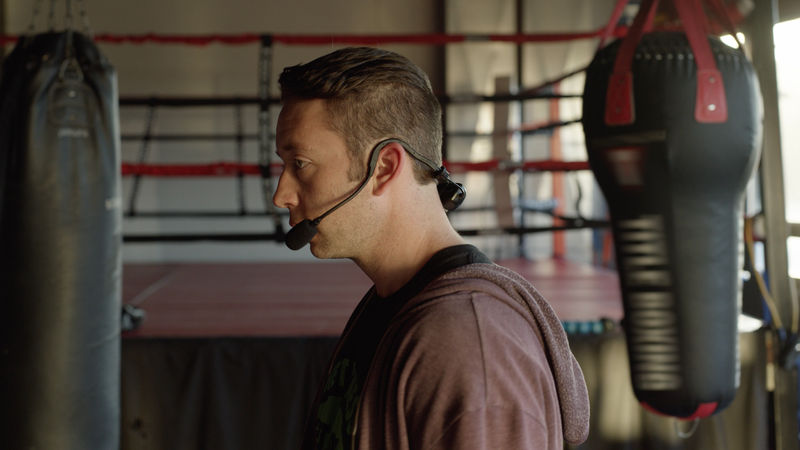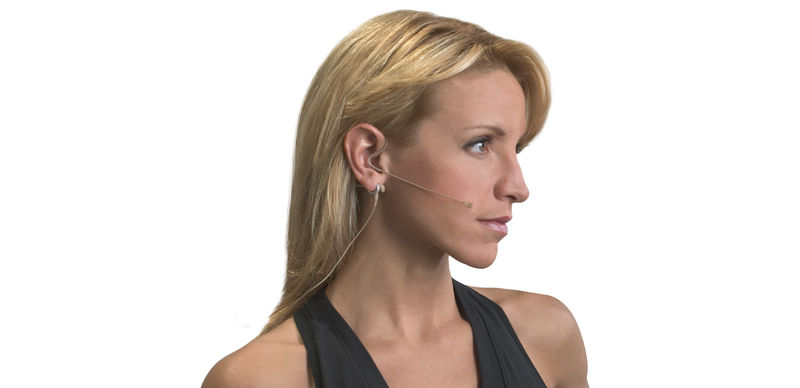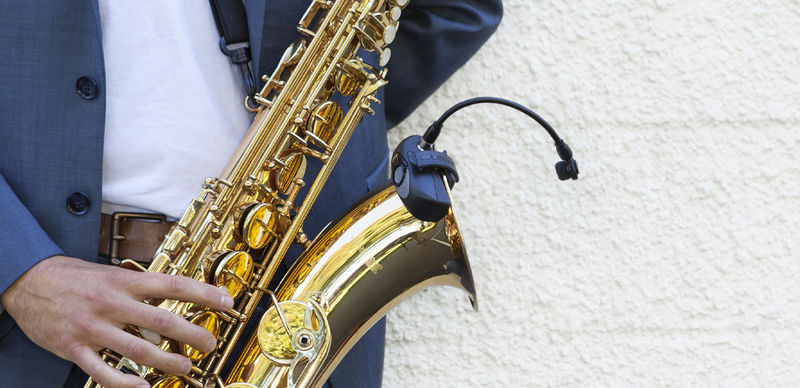Wireless Microphone Buyers Guide
A wireless system’s main purpose is to replace the cable that connects a microphone or instrument to an audio system. Yet this technology has dramatically changed almost every aspect of live sound. “Why go wireless?” is a question from days gone by. Now the question is “Why not?” Once upon a time, wireless microphones were unique to the point of being a novelty. Their installation and operation required a bit of technical know-how—and patience. Beginning in the early 1980s, Samson was one of the first wireless manufacturers offering affordable solutions that helped shape modern musical and theatrical performances. Today, Samson offers wireless microphone systems for many applications including musical performance, theatrical production, fitness instruction, video production, presentations, and houses of worship.
Wireless Basics
All wireless microphone systems require three elements: Microphone, Transmitter and Receiver
The Microphone
The microphone captures sound waves and converts them into electrical signals which are fed to the transmitter. Coming in a variety of formats and designs, selecting the right microphone will ensure the best results in any given situation, from handheld, lavalier, headset, earset to clip-on instrument microphones. In the case of Guitar and Bass Wireless Systems, a 1/4″ plug that is connected into an instrument’s output jack is used in place of a microphone capsule.
The Transmitter
The transmitter has two main functions. The first is to provide power to the microphone—if needed. The second is to take the signal from the microphone, convert it into radio waves, and send it to the receiver. Transmitters are designed to be compact and unobtrusive. The transmitter is often in the form of a beltpack, or it can be incorporated into the body of the microphone, or connected by way of a module.
The Receiver
The receiver is the last stop for the audio signal in a wireless system. Once the signal is received from the transmitter, it is converted back to an audio signal that can be connected to the house mixing console, a personal combo amplifier, your PA system, as well as a personal computer or digital camera. Be sure that the receiver for the wireless system you choose has the right outputs to connect to your other equipment—or make sure you have the necessary adaptors needed to make the proper connections.

Handheld Wireless Microphone Systems
Handheld microphones are the mainstay of lead vocalists and on-the-street interviewers. The microphone element, or diaphragm, is larger than those found on body-worn styles and can handle a wider dynamic range, which is one reason they remain popular with singers. Wireless handheld microphones are excellent for dynamic speakers who are ready to move out from behind the podium, for powerful presenters, and for Emcees. Wireless handheld microphones are the perfect solution for taking questions from a live audience. Wireless handheld mics are popular with entertainers, singers, DJs, and karaoke performers. And of course, the handheld wireless mic is indispensable for the maid-of-honor, best man and other wedding toasters.

| XPD2 Handheld - | XPDm Handheld - | Concert 88x Handheld - | Concert 99 Handheld - | |
|---|---|---|---|---|
| Type | 2.4GHz Digital | 2.4GHz Digital | UHF | UHF |
| Frequencies | n/a | n/a | 100 | 80 |
| Compatible Systems per band | 2 | 2 | 8 | 8 |
| Mic Capsule | Q6 Dynamic | Q6 Dynamic | Q7 Dynamic | Q8 Dynamic |
| Transmitter Battery | 2xAA / 20 hours | 2xAA / 20 hours | 2xAA / 8 hours | 2xAA / 8 hours |
| Receiver Type | USB Stick | Tabletop | Half-rack | Half-rack |
| Rack-mountable | No | No | Yes - Rack kit included | Yes - Rack kit included |
| Receiver Output Connections | USB, 1/8" | XLR, 1/4", 1/8" | XLR, 1/4" | XLR, 1/4" |
| Antenna Distribution Capable | No | No | No | Yes |

Headset Wireless Microphone Systems
Headset microphones provide a hands-free solution for all types of musicians, performers, instructors, and presenters. Wireless headset mics are designed to fit comfortably on the head, and move with the musician. Lead singers can keep their hands free for dramatic use, or to play a hand-held percussion instrument as they move about the stage. Headset microphones are also a valuable asset for classroom leaders and seminar presenters where again, the hands are kept free and the microphone moves with the presenter. Keynote speakers can move from the podium, step down from the dais, and still be heard clearly—even if they turn their back to the crowd to write on a board or point at a graphic.

| XPD2 Headset - | XPDm Headset - | Concert 88x Headset - | |
|---|---|---|---|
| Type | 2.4GHz Digital | 2.4GHz Digital | UHF |
| Frequencies | n/a | n/a | 100 |
| Compatible Systems per band | 2 | 2 | 8 |
| Mic Capsule | DE5 Headset | DE5 Headset | HS5 Headset |
| Transmitter Battery | 2xAA / 20 hours | 2xAA / 20 hours | 2xAA / 8 hours |
| Receiver Type | USB Stick | Tabletop | Half-rack |
| Rack-mountable | No | No | Yes - Rack kit included |
| Receiver Output Connections | USB, 1/8" | XLR, 1/4", 1/8" | XLR, 1/4" |
| Antenna Distribution Capable | No | No | No |

Fitness Headset Wireless Microphones
A subset of the headset microphone group, the fitness headset systems are designed for fitness instructors, group ex instructors and active performers. Samson AirLine Fitness systems feature micro transmitters, many which are integrated into the headset microphone, providing yoga, aerobic, martial arts, and other physical exercise instructors the freedom to conduct a class as they demonstrate poses, postures, or other activities without impediment.

| AirLine XD Fitness - | AirLine XDm Fitness - | AirLine 77 Fitness - | AirLine 88x Fitness - | AirLine 99m Fitness - | AirLine 99 Fitness - | |
|---|---|---|---|---|---|---|
| Type | 2.4GHz Digital | 2.4GHz Digital | UHF | UHF | UHF | UHF |
| Frequencies | n/a | n/a | 1 | 100 | 100 | 80 |
| Compatible Systems per band | 2 | 2 | 6 | 8 | 8 | 8 |
| Mic Capsule | Qe Fitness Headset | Qe Fitness Headset | Qe Fitness Headset | AE50x capsule (integrated into transmitter) | Qe Fitness Headset | Qe Fitness Headset |
| Transmitter Battery | Lithium Ion Rechargeable / 6 Hours | Lithium Ion Rechargeable / 6 Hours | 1xAAA / 8 Hours | Lithium Ion Rechargeable / 8 Hours | Lithium Ion Rechargeable / 8 Hours | Lithium Ion Rechargeable / 8 Hours |
| Receiver Type | USB Stick | Tabletop | Half-rack | Half-rack | Tabletop | Half-rack |
| Rack-mountable | No | No | Yes - Rack kit included | Yes - Rack kit included | No | Yes - Rack kit included |
| Receiver Output Connections | USB, 1/8" | XLR, 1/4", 1/8" | XLR, 1/4" | XLR, 1/4" | XLR, 1/4", 1/8" | USB, 1/8" |
| Antenna Distribution Capable | No | No | No | No | No | Yes |

Earset Wireless Microphones
Lightweight, discreet, and nearly invisible, the earset microphone loops around a single ear, extending an inconspicuous microphone element near the corner of the mouth to pick up every word and nuance. The earset microphone is favored by onstage actors as well as presenters, conference leaders, tradeshow spokespeople, and for certain theatrical applications. The Samson AirLine AH2 transmitter includes a miniature transmitter mounted to the back of an earset microphone for an extremely mobile solution.

| AirLine Micro Earset - | Concert 88x Earset - | Concert 99 Earset - | |
|---|---|---|---|
| Type | UHF | UHF | UHF |
| Frequencies / Compatible Systems per band | 1 / 6 | 100 / 8 | 80 / 8 |
| Mic Capsule | Integrated omnidirectional micro capsule | SE10 Earset | SE10 Earset |
| Transmitter Battery | Lithium Ion Rechargeable / 10 hours | 2xAA / 8 hours | 2xAA / 8 hours |
| Receiver Type | Portable | Half-rack | Half-rack |
| Receiver Battery | Lithium Ion Rechargeable / 6 hours | n/a | n/a |
| Rack-mountable | No | Yes - Rack kit included | Yes - Rack kit included |
| Receiver Output Connections | 1/8" (3.5mm) | XLR, 1/4", 1/8" | XLR, 1/4" |
| Antenna Distribution Capable | No | No | Yes |

Lavalier Wireless Microphones
Often referred to as a presentation microphone, the lavalier microphone is designed to be inconspicuous and discreet. The diminutive lavalier includes a clip-on mount that allows it to be clipped to any available piece of clothing. Lavalier microphone systems are used for professional presentations and by keynote speakers wishing to be free of the limited mobility provided by the podium microphone. You can often see lavalier mics on each member of a round table discussion, and they are ideal for use with head-to-head interviews on stage, video, and for broadcast.

| Concert 99 Presentation - | Concert 88x Presentation - | XPD2 Lavalier - | XPDm Lavalier - | |
|---|---|---|---|---|
| Type | UHF | UHF | 2.4GHz Digital | 2.4GHz Digital |
| Frequencies | 80 | 100 | n/a | n/a |
| Compatible Systems per band | 8 | 8 | 2 | 2 |
| Mic Capsule | LM10 Lavalier | LM5 Lavalier | LM8 Lavalier | LM8 Lavalier |
| Transmitter Battery | Lithium Ion Rechargeable / 8 Hours | 2xAA / 8 hours | 2xAA / 20 hours | 2xAA / 20 hours |
| Receiver Type | Half-rack | Half-rack | USB Stick | Tabletop |
| Rack-mountable | Yes - Rack kit included | Yes - Rack kit included | No | No |
| Receiver Output Connections | XLR, 1/4" | XLR, 1/4" | USB, 1/8" | XLR, 1/4", 1/8" |
| Antenna Distribution Capable | Yes | No | No | No |

Wind Instrument Wireless Microphones
Rather than using the clip mount to attach to an article of clothing, certain wireless microphones such as the Samson AirLine AWX Wind Instrument System can clip directly to the bell of a wind instrument such as a saxophone. This allows the performer to enjoy freedom and mobility on stage, without having to stand still and play to a stationary microphone.

| AirLine AWXm Wind Instrument - | AirLine AWX Wind Instrument - | ||
|---|---|---|---|
| Type | UHF | UHF | |
| Frequencies | 100 | 80 | |
| Compatible Systems per band | 8 | 8 | |
| Mic Capsule | HM60 Instrument Mic | HM60 Instrument Mic | |
| Transmitter Battery | Lithium Ion Rechargeable / 8 Hours | Lithium Ion Rechargeable / 8 Hours | |
| Receiver Type | Tabletop | Half-rack | |
| Rack-mountable | No | Yes - Rack kit included | |
| Receiver Output Connections | XLR, 1/4", 1/8" | XLR, 1/4" | |
| Antenna Distribution Capable | No | Yes | |

Guitar and Bass Wireless Systems
Instrument wireless systems allow guitarists, bass players, and other electric and acoustic/electric performers to enjoy the ability to move freely about the stage—or the entire performance space—without the restrictions of a cumbersome cable connection. The transmitter plugs into the 1/4″ instrument output and sends the signal to the receiver. Samson AirLine 88x Guitar models include a transmitter that plugs directly into the instrument without the need of a beltpack.

| Concert 88x Guitar - | AirLine 88x Guitar - | Concert 99 Guitar - | |
|---|---|---|---|
| Type | UHF | UHF | UHF |
| Frequencies | 100 | 100 | 80 |
| Compatible Systems per band | 8 | 8 | 8 |
| Transmitter | CB88 Beltpack | AG8 Plugin | CB99 Beltpack |
| Transmitter Battery | 2xAA / 8 hours | 1xAAA / 12 Hours | 2xAA / 8 hours |
| Receiver Type | Half-rack | Half-rack | Half-rack |
| Rack-mountable | Yes - Rack kit included | Yes - Rack kit included | Yes - Rack kit included |
| Receiver Output Connections | XLR, 1/4" | XLR, 1/4" | XLR, 1/4" |
| Antenna Distribution Capable | No | No | Yes |

Multi-Channel Wireless
Samson offers systems equipped with two and even four handheld microphones operating via a single receiver, providing a cost-effective way to accommodate multiple users for presentations, Q & A sessions, and vocal ensembles. When searching for the perfect wireless microphone configuration for your application, be sure to check out the all-in-one combo systems which include a handheld transmitter, beltpack transmitter and receiver, along with a headset microphone and lavalier microphone. Simply use the appropriate microphone to ensure the best results for task at hand.

| Concert 288 Handheld - | Concert 288m Handheld - | Stage 200 - | Stage 212 - | Stage 412 - | XPD2m Handheld - | |
|---|---|---|---|---|---|---|
| Type | UHF | UHF | VHF | VHF | VHF | 2.4GHz Digital |
| Dual / Quad | Dual | Dual | Dual | Dual | Quad | Dual |
| Frequencies per Channel | 16 | 100 | 1 | 12 | 6 | n/a |
| Compatible Systems | 8 per band | 4 per band | 4 | 3 | 3 | 1 |
| Available Configurations | Dual Handheld, Presentation, All-In-One | Dual Handheld, Presentation, All-In-One | Dual Handheld | Dual Handheld | Quad Handheld | Dual Handheld, Presentation |
| Transmitter Battery | 2xAA / 8 hours | 2xAA / 8 hours | 2xAA / 12 hours | 2xAA / 10 hours | 2xAA / 10 hours | 2xAA / 20 hours |
| Receiver Type | Half-rack | Tabletop | Tabletop | Tabletop | Tabletop | Tabletop |
| Rack-mountable | Yes - Rack kit included | No | No | No | No | No |
| Receiver Output Connections | Dual XLR, Mixed 1/4" | Dual XLR, Mixed 1/4", Mixed 1/8" | Dual 1/4", Mixed XLR | Dual 1/4", Mixed XLR | 4x 1/4", 3x Mixed XLR | Dual XLR, Mixed 1/4", Mixed 1/8" |

Wireless for Video Production
In this booming age of video blogging and online content creation, wireless compatibility with smartphones, tablets, DSLR cameras and camcorders can offer unparalleled performance and convenience. Samson Go Mic Mobile® was the first professional wireless microphone system that connected directly to smartphones without the need for cumbersome adaptors or interfaces, turning your phone into a pro-level video camera capable of capturing high definition audio anywhere.

| Go Mic Mobile® Lavalier - | |||
|---|---|---|---|
| Type | 2.4GHz Digital | ||
| Frequencies / Compatible Systems per band | n/a / 2 | ||
| Available Configurations | Beltpack Lavalier, Handheld | ||
| Transmitter Battery | 2xAA / 20 hours | ||
| Receiver Battery | Lithium Ion Rechargeable / 13 hours | ||
| Receiver Mounting | Smartphone, Tablet, 1/4"-20, Shoe mount | ||
| Receiver Output Connections | USB, 1/8" | ||
| iOS / Android Connectivity | Yes | ||
Analog vs Digital
Wireless audio systems use radio waves to carry a signal. Virtually all analog wireless audio uses a system called frequency modulation (FM)—when referring to a digital wireless system, the technique is called frequency shift keying (FSK). The term itself is descriptive of the process: The frequency of an electromagnetic radio wave is modulated (that is, continuously varied) by an electrical audio wave, or digital in the case of a digital system a digital bit (represented by a 0 or 1). The radio wave itself is inaudible, since it is well above the range of human hearing (which only extends as high as about 20 kHz). Its sole function is to carry the signal over long distances—thus, it is called a carrier signal. It is only when a radio wave is carrying information that it can be referred to as a radio signal.
The question of which type of system is better or worse is not so straightforward. Each type of wireless method has it advantages and disadvantages. There are factors not related to the transmission method that can make a system sound better or be preferable for your application, such as the microphone, or size/design of the receiver.
Digital wireless microphone systems tend to have better dynamic range and frequency response as well as not incurring noise at the end of the wireless range. Analog systems have to compress the dynamic range prior to transmission. That isn’t to say analog systems are noisy, modern analog wireless systems have been designed to include high-quality audio sections that are heard on the biggest stages and broadcasts around the world. However, analog systems will broadcast better at the end of the wireless range, although with audible noise, whereas with a digital system may drop out completely.
Latency is the time delay between the signal input and output in a system. Analog systems have virtually no latency, while digital wireless systems experience some amount of latency. The amount of latency that can be tolerated depends on the application as well as the people involved. For speaking or video applications, latencies under 20ms are acceptable. However, for performance applications, especially those where a performer will be able to monitor themselves or need to lock in with a band, latency generally needs to be much lower to be acceptable.
Both analog and digital systems’ performance can be diminished by RF (radio frequency) interference. When using a UHF or VHF system, you need to coordinate the frequencies to avoid direct interference from active TV broadcast and other wireless sources, as well as other performers using a wireless system. Many digital wireless systems do not give the user the ability to select the operating channel, instead they automatically scan and hop between frequencies to avoid interference from other devices in the spectrum. And with the number of wireless devices (including WIFI) taking up bandwidth in the frequencies ranges that digital wireless microphones operate, limit the number of systems that can operate simultaneously.
Some Closing Thoughts
Wireless microphones are great. They can eliminate long and unsightly cable runs. They provide heightened levels of mobility to dynamic performers of all stripes. They offer great convenience to news gathers and online content creators by offering cable-free connections, plus discreet and unobtrusive mic placement. Samson brings continuous innovation to the wireless microphone industry, creating systems that are designed to ensure your audio requirements are achieved for whatever your application.